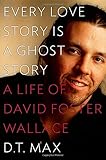 Six months after David Foster Wallace’s suicide, The New Yorker published a novella-length piece by journalist D.T. Max on Wallace’s last difficult years and his encompassing effort to surpass Infinite Jest. That article started the drumbeat for two books: The first, The Pale King, was released last April and pored over by critics and readers; the second, Max’s biography, Every Love Story is a Ghost Story: The Life of David Foster Wallace, arrives next week. The biography was written with the cooperation of Wallace’s family and is the first definitive treatment of the author’s life.
Six months after David Foster Wallace’s suicide, The New Yorker published a novella-length piece by journalist D.T. Max on Wallace’s last difficult years and his encompassing effort to surpass Infinite Jest. That article started the drumbeat for two books: The first, The Pale King, was released last April and pored over by critics and readers; the second, Max’s biography, Every Love Story is a Ghost Story: The Life of David Foster Wallace, arrives next week. The biography was written with the cooperation of Wallace’s family and is the first definitive treatment of the author’s life.
What follows are the book’s opening paragraphs:
Every story has a beginning and this is David Wallace’s. He was born in Ithaca, New York, on February 21, 1962. His father, James, was a graduate student in philosophy at Cornell, from a family of professionals. David’s mother, Sally Foster, came from a more rural background, with family in Maine and New Brunswick, her father a potato farmer. Her grandfather was a Baptist minister who taught her to read with the Bible. She had gotten a scholarship to a boarding school and from there gone to Mount Holyoke College to study English. She became the student body president and the first member of her family to get a bachelor’s degree.
Jim and Sally had their daughter, Amy, two years after David, by which time the family had moved to Champaign-Urbana, twin cities in central Illinois and the home of the state’s most important public university. The family had not wanted to leave Cornell—Sally and Jim loved the rolling landscape of the region—but Wallace had been offered a job in the philosophy department in the university and felt he could not turn it down. The couple were amazed when they arrived to see how bleak their new city was, how flat and bare. But soon, happily, Jim’s appointment turned into a tenure-track post, Sally went back to school to get her master’s in English literature, and the family settled in, eventually, in 1969, buying a small yellow two-story house on a one-block-long street in Urbana, near the university. Just a few blocks beyond were fields of corn and soybeans, prairie farmland extending as far as the eye could see, endless horizons.
Here, Wallace and his sister grew up alongside others like themselves, in houses where learning was highly valued. But midwestern virtues of normality, kindness, and community also dominated. Showing off was discouraged, friendliness important. The Wallace house was modest in size and looked out at other modest-sized houses. You were always near your neighbors and kids in the neighborhood lived much of their lives, a friend remembers, on their bikes, in packs. Every other kid in that era, it seemed, was named David.
There was elementary school at Yankee Ridge and then homework. The Wallaces ate at 5:45 p.m. Afterward, Jim Wallace would read stories to Amy and David. And then every night the children would get fifteen minutes each in their beds to talk to Sally about anything that was on their minds. Lights-out was at 8:30 p.m., later as the years went on. After the children were asleep, the Wallace parents would talk, catch up with each other, watch the 10 p.m. evening news, and Jim would turn the lights out at 10:30 exactly. He came home every week from the library with an armful of books. Sally especially loved novels, from John Irving to college classics she’d reread. In David’s eyes, the household was a perfect, smoothly running machine; he would later tell interviewers of his memory of his parents lying in bed, holding hands, reading Ulysses to each other.
For David, his mother was the center of the universe. She cooked his favorites, roast beef and macaroni and cheese, and baked his chocolate birthday cake and drove the children where they needed to go in her VW Bug. Later, after an accident, she replaced it with a Gremlin. She made beef bourguignonne on David’s birthday and sewed labels into his clothes (some of which Wallace would still wear in college).








